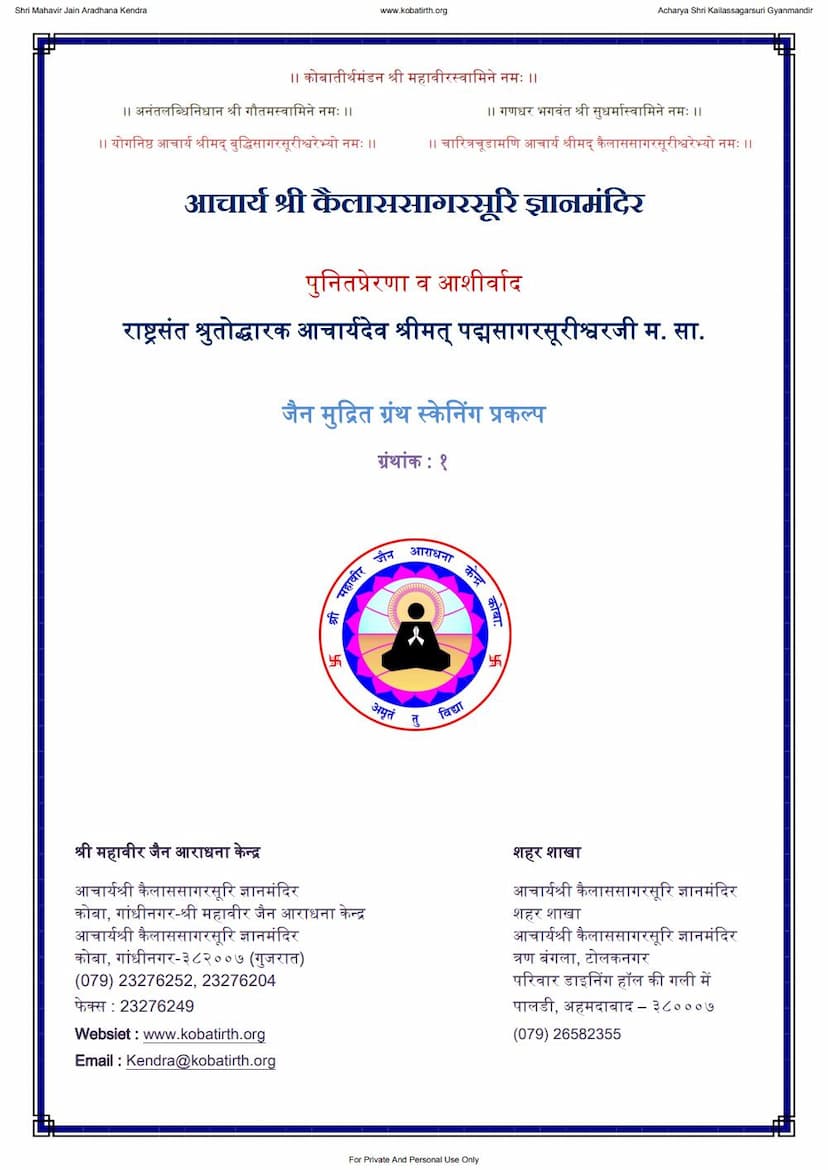Navtattva Samvedan Prakaranam
Added to library: September 2, 2025

Summary
Here's a comprehensive summary of the Jain text "Navtattva Samvedan Prakaranam" by Buddhisagar, based on the provided text:
Overall Purpose and Context:
"Navtattva Samvedan Prakaranam," authored by Buddhisagar and presented with a commentary (Vritti) by the same author, is a Jain text dedicated to explaining the fundamental principles of Jainism, specifically the "Nine Tattvas" (Navtattva). The text aims to elucidate these core truths in a clear and accessible manner for the benefit of seekers of spiritual liberation (moksha). The work is presented as a valuable contribution to Jain literature, intended for private and personal use.
Key Themes and Structure:
The text systematically explores the nine essential tattvas, which are the foundational categories of reality in Jain philosophy. The author begins by establishing the importance of understanding these tattvas for spiritual progress, emphasizing that without this knowledge, one cannot properly abandon what is to be abandoned and embrace what is to be embraced for liberation.
The book's structure follows a logical progression:
-
Introduction and Acclamation: The text opens with salutations to revered Jain figures like Lord Mahavir, Gautam Swami, Sudharma Swami, and the Acharyas. It acknowledges the sponsorship and support for the publication.
-
Exposition of Jain Principles:
- Praise for Jain Teachings: The author highlights the unique depth and comprehensive nature of Jain teachings on the nine tattvas, stating they are not found with such clarity in other philosophical systems.
- The Author's Intent: The author expresses humility about their own intellect but states their purpose is to present the essence of these tattvas.
- Historical Context: A verse indicates the commentary was completed in the Vikram era 13th century (specifically the first half). The original text has 117 verses, and the commentary has over 600.
- The Nine Tattvas (Navtattva): The text systematically elaborates on each of the nine tattvas. While the provided excerpt focuses on the initial ones and then delves deeply into certain aspects, the core nine tattvas are understood to be:
- Jiva (Soul): The soul, characterized by consciousness, individual substance, and karma.
- Ajiva (Non-soul): Matter, space, time, dharma (principle of motion), and adharma (principle of rest).
- Punhya (Merit/Virtue): Karmic matter that leads to pleasant results.
- Papa (Demerit/Sin): Karmic matter that leads to unpleasant results.
- Asrava (Influx of Karma): The causes for the inflow of karmas into the soul.
- Samvara (Stoppage of Karma): The means to stop the influx of karmas.
- Nirjara (Shedding of Karma): The process of shedding accumulated karmas.
- Bandha (Bondage of Karma): The binding of karmas to the soul.
- Moksha (Liberation): The state of ultimate freedom from karma and the cycle of birth and death.
-
Detailed Explanations of Tattvas (with emphasis on specific aspects):
- Deva Tattva (Deity): The text describes the liberated soul (Siddha) as the ultimate God – eternal, blissful, omniscient, and free from all imperfections and worldly attachments.
- Guru Tattva (Spiritual Teacher): The qualities of a true spiritual guide are elaborated, emphasizing their detachment from passions (kashayas), adherence to the path of liberation, knowledge of the tattvas, mastery of conduct, and practice of austerities.
- Shravaka Tattva (Lay Follower): The characteristics of an ideal lay follower are presented, highlighting their understanding of the tattvas, adherence to vows (anuvratas), practice of vows of conduct (gunavratas) and training vows (shikshavratas), charity, hospitality, and virtuous conduct.
- Virtues (Yati Dharma): The text expounds on ten cardinal virtues for ascetics (Yati Dharma), which are crucial for spiritual progress and eventual liberation. These include forgiveness (Kshama), humility (Mardava), straightforwardness (Rijuta), contentment (Samtoṣa), truthfulness (Satya), purity (Shaucha), self-control (Sanyama), austerity (Tapa), non-possession (Tyaga), and chastity/celibacy (Brahmacharya). Each virtue is described with its significance and the path to its attainment.
- Knowledge (Jnana): The five types of knowledge in Jainism are explained: Mati (sense perception), Shruta (scriptural knowledge), Avadhi (clairvoyance), Manahparyaya (telepathy), and Kevala (omniscience).
- Conduct (Charitra): The five types of conduct are described: Samayika (equanimity), Chedopasthapaniya (re-establishment of vows), Pariharvishuddhi (purification through austerities), Sukshma-samparaaya (subtle passions), and Yathakhyata (perfect conduct).
- Karma Theory: The text delves into the intricacies of karma, including its classification into 8 types and numerous sub-types (Prakriti), their durations (Sthiti), intensities (Anubhava), and modes of bondage (Pradesha). The influence of passions (Kashayas) and the stages of spiritual development (Gunsthana) are also discussed in relation to karma.
- Syadvada (Anekantavada): The fundamental Jain principle of manifold perspectives or conditional predication is explained as the means to understand reality and avoid attachment to absolute views. The text highlights how this principle helps in comprehending the nature of existence, change, and permanence.
-
The Path to Liberation: The text outlines the spiritual journey, emphasizing the importance of right faith (Samyaktva), right knowledge (Samyak Jnana), and right conduct (Samyak Charitra) as the means to achieve liberation. It details how by practicing virtues, controlling passions, shedding karmas through austerities, and purifying the soul, one can attain omniscience and ultimately Moksha.
Key Concepts and Emphasis:
- Detachment: A strong emphasis is placed on detachment from worldly possessions, relationships, and sensory pleasures.
- Austerities (Tapa): Austerities, both internal and external, are presented as crucial tools for purifying the soul and shedding karmic bondage.
- Purity: Both physical and mental purity are advocated as essential for spiritual advancement.
- Discrimination (Viveka): The ability to discriminate between the soul and non-soul, the virtuous and the sinful, is highlighted as a prerequisite for progress.
- Humility and Gratitude: The author expresses humility about their work and gratitude towards those who supported its publication.
In essence, "Navtattva Samvedan Prakaranam" serves as a didactic guide to understanding the fundamental truths of Jainism, providing a structured and insightful exploration of the nine tattvas and the path to spiritual liberation, all within the framework of Jain philosophy and practice.